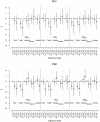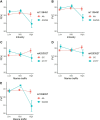Exposure to traffic-related particle matter and effects on lung function and potential interactions in a cross-sectional analysis of a cohort study in west Sweden
- PMID: 33077557
- PMCID: PMC7574932
- DOI: 10.1136/bmjopen-2019-034136
Exposure to traffic-related particle matter and effects on lung function and potential interactions in a cross-sectional analysis of a cohort study in west Sweden
Abstract
Objectives: To investigate the long-term effects of source-specific particle matter (PM) on lung function, effects of Surfactant Protein A (SP-A) and glutathione S-transferase (GST) genes GSTP1 and GSTT1 gene variants and effect modification by single-nucleotide polymorphism (SNP) genotype.
Design: Cohort study with address-based annual PM exposure assigned from annual estimates of size (PM10, PM2.5 and PMBC) and source-specific (traffic, industry, marine traffic and wood burning) dispersion modelling.
Setting: Gothenburg, Sweden.
Participants: The ADult-Onset asthma and NItric oXide Study had 6685 participants recruited from the general population, of which 5216 (78%) were included in the current study with information on all variables of interest. Mean age at the time of enrolment was 51.4 years (range 24-76) and 2427 (46.5%) were men.
Primary and secondary outcome measures: The primary outcome was forced vital capacity (FVC) and forced expiratory volume in 1 s (FEV1). Secondary outcome measures were effects and gene-environment interactions of SP-A and GSTT1 and GSTP1 genotypes.
Results: Exposure to traffic-related PM10 and PM2.5 was associated with decreases in percent-predicted (% predicted) FEV1 by -0.48% (95% CI -0.89% to -0.07%) and -0.47% (95% CI -0.88% to -0.07%) per IQR 3.05 and 2.47 µg/m3, respectively, and with decreases in % predicted FVC by -0.46% (95% CI -0.83% to -0.08%) and -0.47% (95% CI -0.83% to -0.10%). Total and traffic-related PMBC was strongly associated with both FEV1 and FVC by -0.53 (95% CI -0.94 to -0.13%) and -0.43% (95% CI -0.77 to -0.09%) per IQR, respectively, for FVC, and similarly for FEV1. Minor allele carrier status for two GSTP1 SNPs and the GSTT1 null genotype were associated with decreases in % predicted lung function. Three SP-A SNPs showed effect modification with exposure to PM2.5 from industry and marine traffic.
Conclusions: PM exposure, specifically traffic related, was associated with FVC and FEV1 reductions and not modified by genotype. Genetic effect modification was suggested for industry and marine traffic PM2.5.
Keywords: epidemiology; genetics; glutathione S-transferase; lung function; particle matter; surfactant protein A.
© Author(s) (or their employer(s)) 2020. Re-use permitted under CC BY-NC. No commercial re-use. See rights and permissions. Published by BMJ.
Conflict of interest statement
Competing interests: None declared.
Figures


Similar articles
-
Exposure to traffic and lung function in adults: a general population cohort study.BMJ Open. 2015 Jun 24;5(6):e007624. doi: 10.1136/bmjopen-2015-007624. BMJ Open. 2015. PMID: 26109116 Free PMC article.
-
Associations of short-term PM2.5 exposures with nasal oxidative stress, inflammation and lung function impairment and modification by GSTT1-null genotype: A panel study of the retired adults.Environ Pollut. 2021 Sep 15;285:117215. doi: 10.1016/j.envpol.2021.117215. Epub 2021 Apr 24. Environ Pollut. 2021. PMID: 33932759
-
Long-term effects of total and source-specific particulate air pollution on incident cardiovascular disease in Gothenburg, Sweden.Environ Res. 2017 Oct;158:61-71. doi: 10.1016/j.envres.2017.05.036. Epub 2017 Jun 8. Environ Res. 2017. PMID: 28600978
-
Air Pollution and Lung Function in Dutch Children: A Comparison of Exposure Estimates and Associations Based on Land Use Regression and Dispersion Exposure Modeling Approaches.Environ Health Perspect. 2015 Aug;123(8):847-51. doi: 10.1289/ehp.1408541. Epub 2015 Apr 3. Environ Health Perspect. 2015. PMID: 25839747 Free PMC article.
-
Associations of long-term exposure to ambient fine particulate matter and nitrogen dioxide with lung function: A cross-sectional study in China.Environ Int. 2020 Nov;144:105977. doi: 10.1016/j.envint.2020.105977. Epub 2020 Aug 3. Environ Int. 2020. PMID: 32758714
Cited by
-
Personal exposure levels to O3, NOx and PM10 and the association to ambient levels in two Swedish cities.Environ Monit Assess. 2021 Sep 27;193(10):674. doi: 10.1007/s10661-021-09447-7. Environ Monit Assess. 2021. PMID: 34570284 Free PMC article.
-
Genetic susceptibility to airway inflammation and exposure to short-term outdoor air pollution.Environ Health. 2023 Jun 29;22(1):50. doi: 10.1186/s12940-023-00996-7. Environ Health. 2023. PMID: 37386634 Free PMC article.
-
Exposure to long-term ambient air pollution and lung function in adults: a systematic review and meta-analysis.Eur Respir Rev. 2025 Jun 11;34(176):240264. doi: 10.1183/16000617.0264-2024. Print 2025 Apr. Eur Respir Rev. 2025. PMID: 40500128 Free PMC article.
References
-
- Ackermann-Liebrich U, Kuna-Dibbert B, Probst-Hensch NM, et al. . Follow-Up of the Swiss cohort study on air pollution and lung diseases in adults (SAPALDIA 2) 1991–2003: methods and characterization of participants. Sozial- und Präventivmedizin SPM 2005;50:245–63. 10.1007/s00038-005-4075-5 - DOI - PubMed
Publication types
MeSH terms
Substances
LinkOut - more resources
Full Text Sources
Research Materials
Miscellaneous
